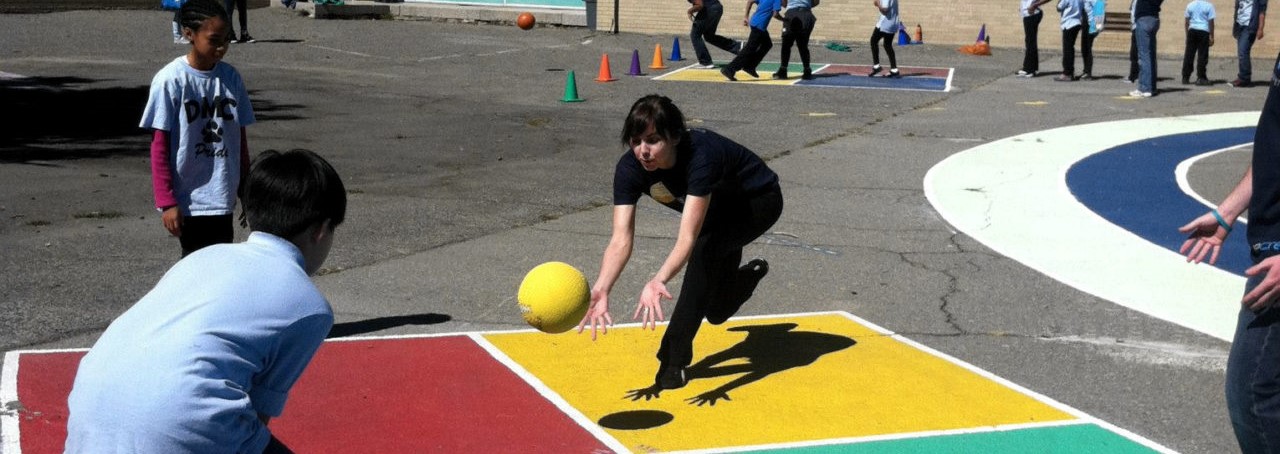
by Emily Cherkin, MEd. “The Screentime Consultant” (Shared with permission) Emily empowers parents to understand and balance family screentime by inspiring a movement around becoming tech-intentional. Emily will be speaking with the faculty, and then interested parents, at BFS in April. Stay tuned! If interested, you can pre-order her book here.
“Play is the work of childhood,” says Swiss psychologist Jean Piaget.
I couldn’t agree more, but I want to expand a little: “Play” (in this case) means children engaging in some self-selected activity that is unstructured, uninterrupted, and unobstructed by adult rules and limits.
In elementary school, my son loved playing foursquare at recess. But, as is typical of 4th graders at recess, the complex and ever-expanding rules of the game meant that most of the recess period was spent arguing, debating, negotiating, and problem-solving. In my view, a perfect use of recess!
Unfortunately, a teacher at the school felt otherwise. To eliminate (!) the conflict, she announced that she would be the lone judge and jury for all future foursquare play. My usually easy-going son came home furious: “How can she think that telling us what to do and how to do it is going to make the game more FUN!?”
He was absolutely right. Sadly, this is a clear example of what well-meaning adults do when they use snowplow parenting and teaching– attempting to go ahead of children to try to mow away obstacles to prevent conflict and distress.
But the problem with this approach is that life is complicated and not a smooth road, and taking away the option for children to figure things out on their own by turning it over to an adult eliminates incredibly important opportunities for children to practice skills– skills like communication, problem-solving, and compromise. Fourth-grade foursquare was not at all about the ball and the squares– it was all about navigating different needs and desires to have fun while doing so.
Not surprisingly, foursquare became a much less popular recess activity when the teacher took over.
So what can we do?
Part of preparing our children for future success (which, in my view, means equipping them with ample opportunities to practice skill building and not focusing solely on rigorous academics and achievement!) means understanding child development.
Even after 12 years of teaching and 16 years of parenting, I am still learning about how different children’s brains are from adult brains and how misguided adults can be when it comes to making decisions about what is “best” for kids (Hint: usually it is actually about what is “best” for adults).
So before the onslaught of teen angst, social media drama, and adolescence hits us all at once, piling up the pre-flood sandbags starts with improving our parental understanding of how children typically develop. Piaget is best known for his theory of neurotypical child development, which he splits into four stages: sensorimotor, preoperational, concrete operational, and formal operational. I find these categories helpful in understanding development at different ages: infancy, preschool and early childhood, later childhood, and adolescence.
Here are my brief summaries of each of Piaget’s four stages:
- Sensorimotor (birth to two years old): In this stage, babies learn about their world through movement and touch. Children see themselves as separate beings from other people and objects. They learn that their actions can cause things to happen and about object permanence, which is the belief that things still exist even when they go away like a parent leaving the room. Through their interactions with caregivers, they develop early language skills.
- Preoperational (two to seven years old): In this stage, young children learn that words and pictures can represent objects, which is called symbolic thinking. They are egocentric, finding it difficult to take the perspective of others (think “three-nagers”). Very concrete thinkers, they struggle with logic and point of view, which makes the concept of sharing difficult at this age because they do not understand the significance or importance of this skill. Language development emerges.
- Concrete operational (seven to eleven years old): Children’s thinking grows more logical and organized in this stage, though it is still quite concrete. They start to use reasoning (i.e., inductive logic) to make sense of the world, and they are getting better at understanding other people’s points of view. This age group struggles with abstract and hypothetical concepts.
- Formal operational (adolescence to adulthood): In this final stage, abstract thinking develops. Tweens and teens can reason about hypothetical situations and have thoughts about moral or philosophical issues. They use deductive reasoning and can see multiple potential solutions to a problem. They can plan for the future.
Piaget’s four stages represent neurotypical child development. New levels of comprehension unfold and build on previously learned knowledge. This flow of neurotypical development makes sense. However, our interruption of this flow through the introduction of screens too early or too often interferes with this logical unfolding (or adults taking over foursquare games). Babies cannot walk before they learn to crawl. Tweens cannot manage social media toxicity until they develop perspective-taking—and even then, online toxicity can still be painful, to which many adults can attest (and their brains are fully developed!).
For those foursquare-playing fourth graders, solidly in the concrete operational stage, their increased use of reasoning to make sense of the world means they are working to better understand other children’s points of view.
And what better place to do that than in a child-led game of foursquare, free of adult interference, where they can practice and hone those skills?

